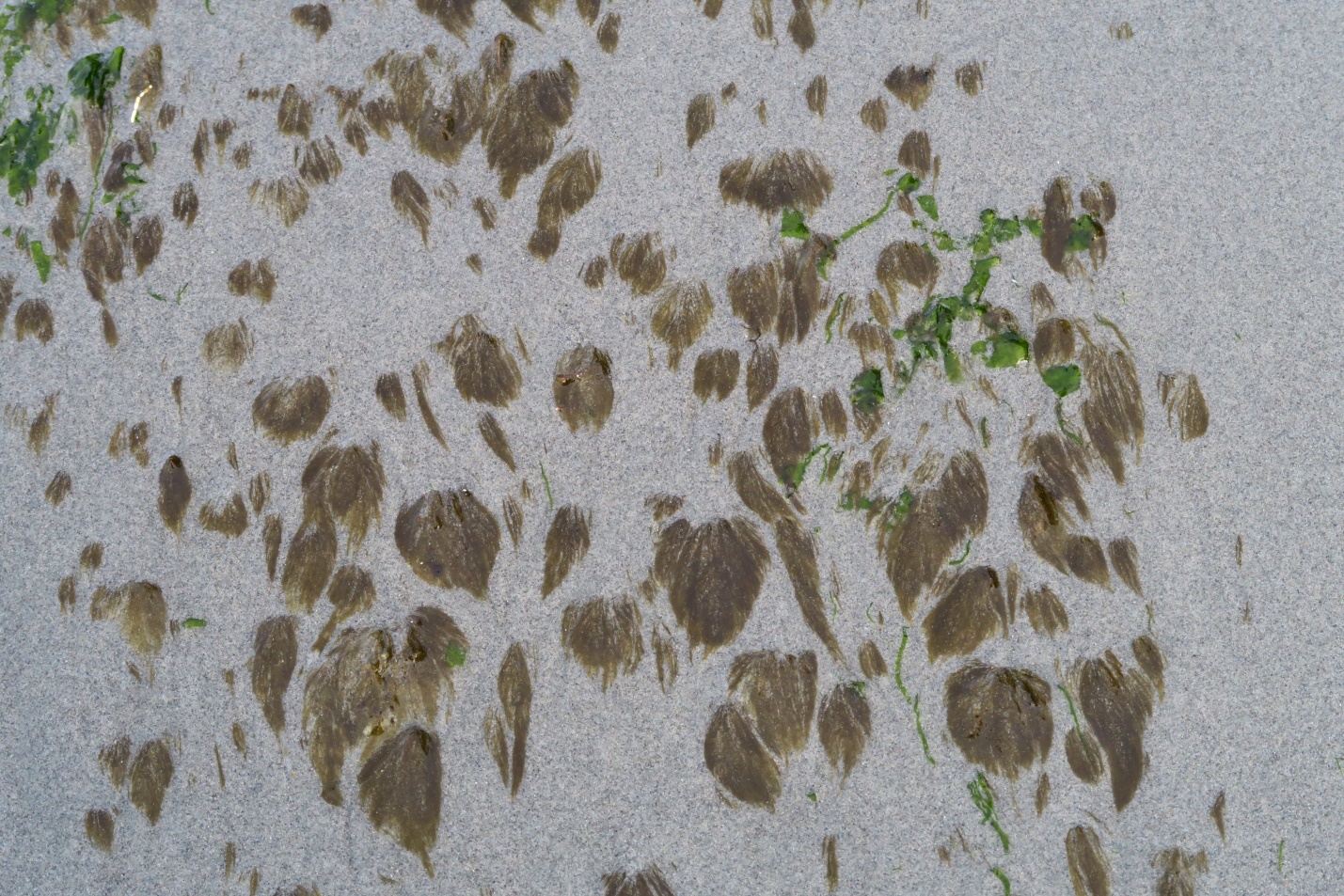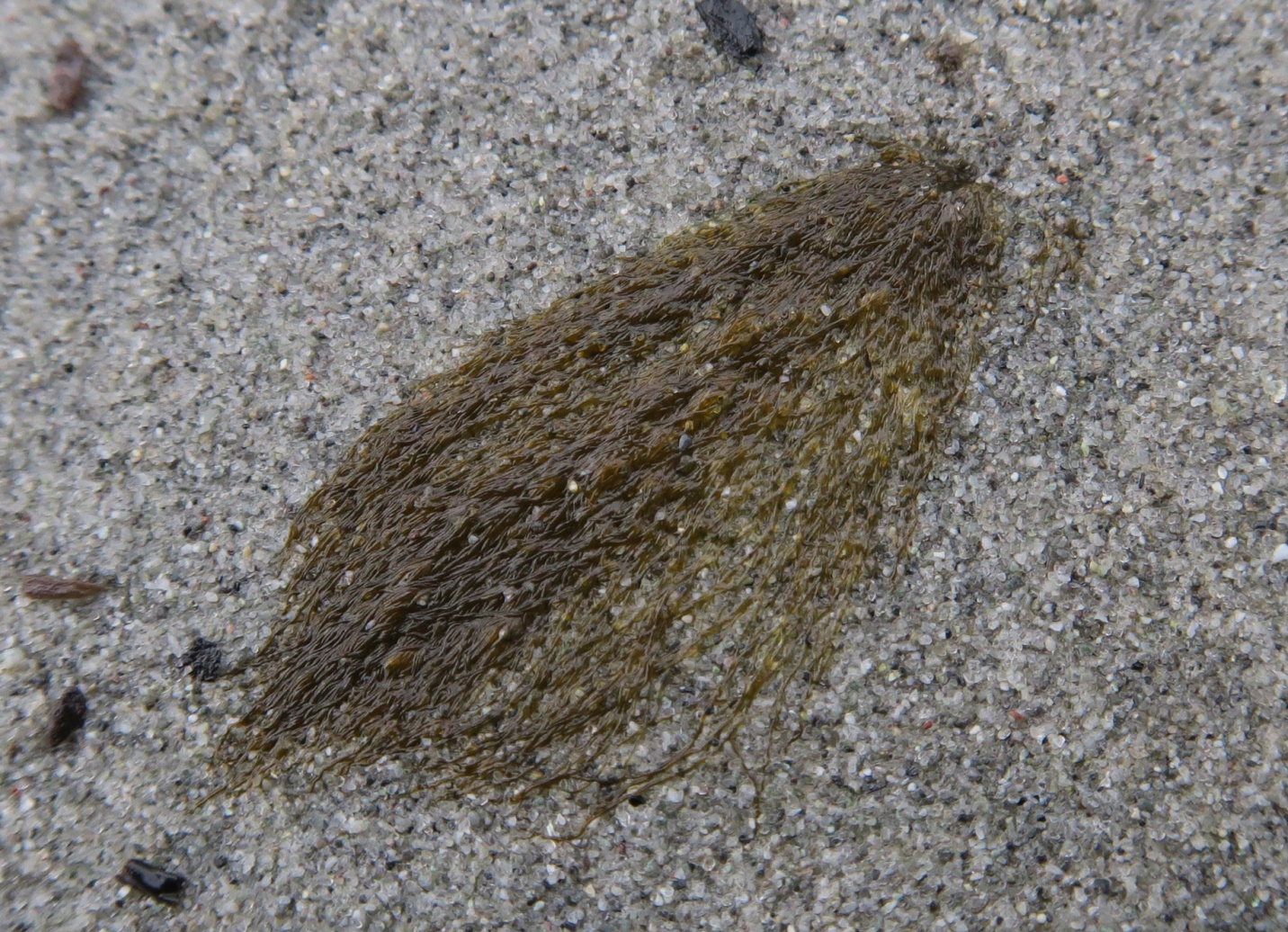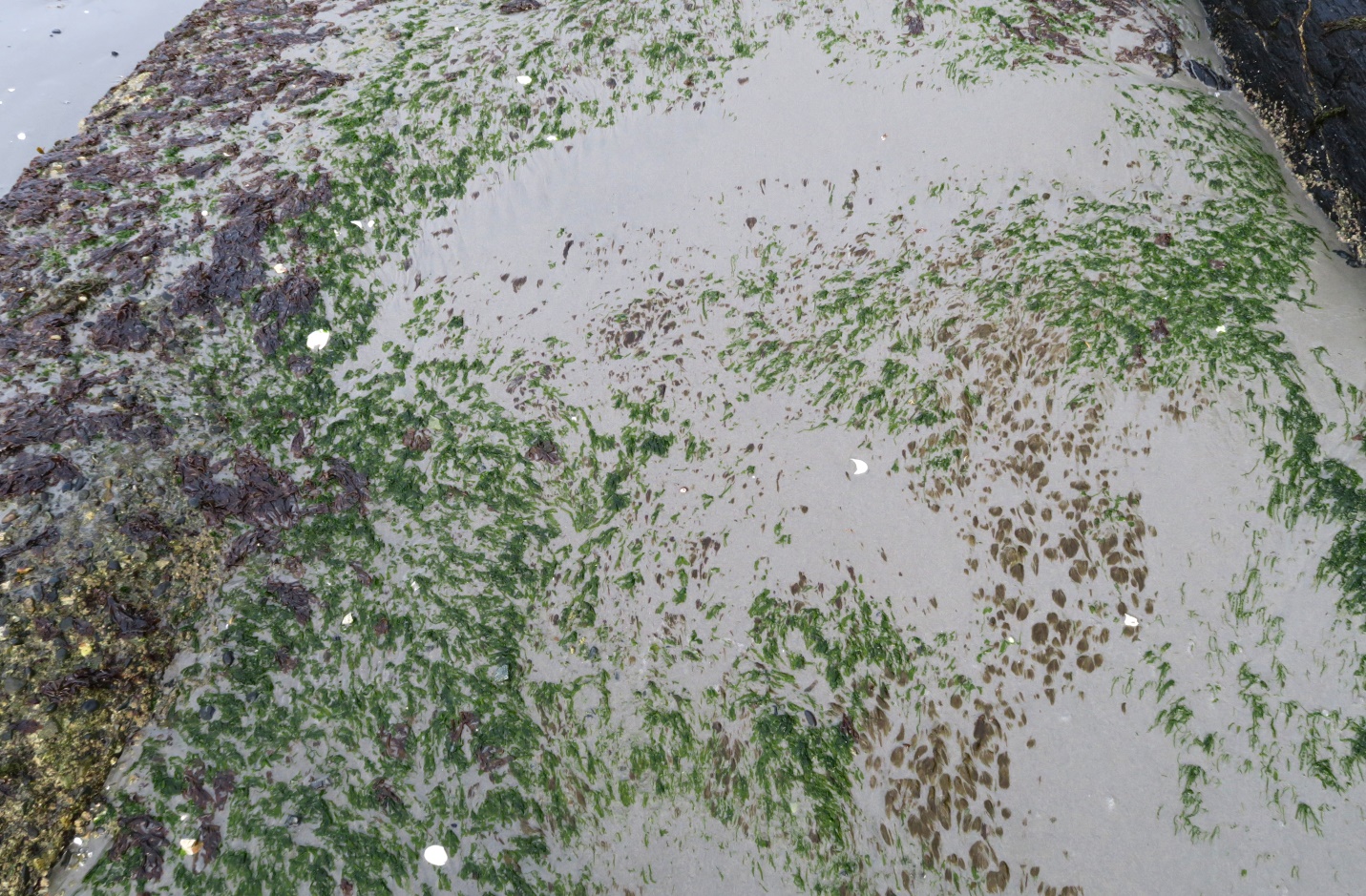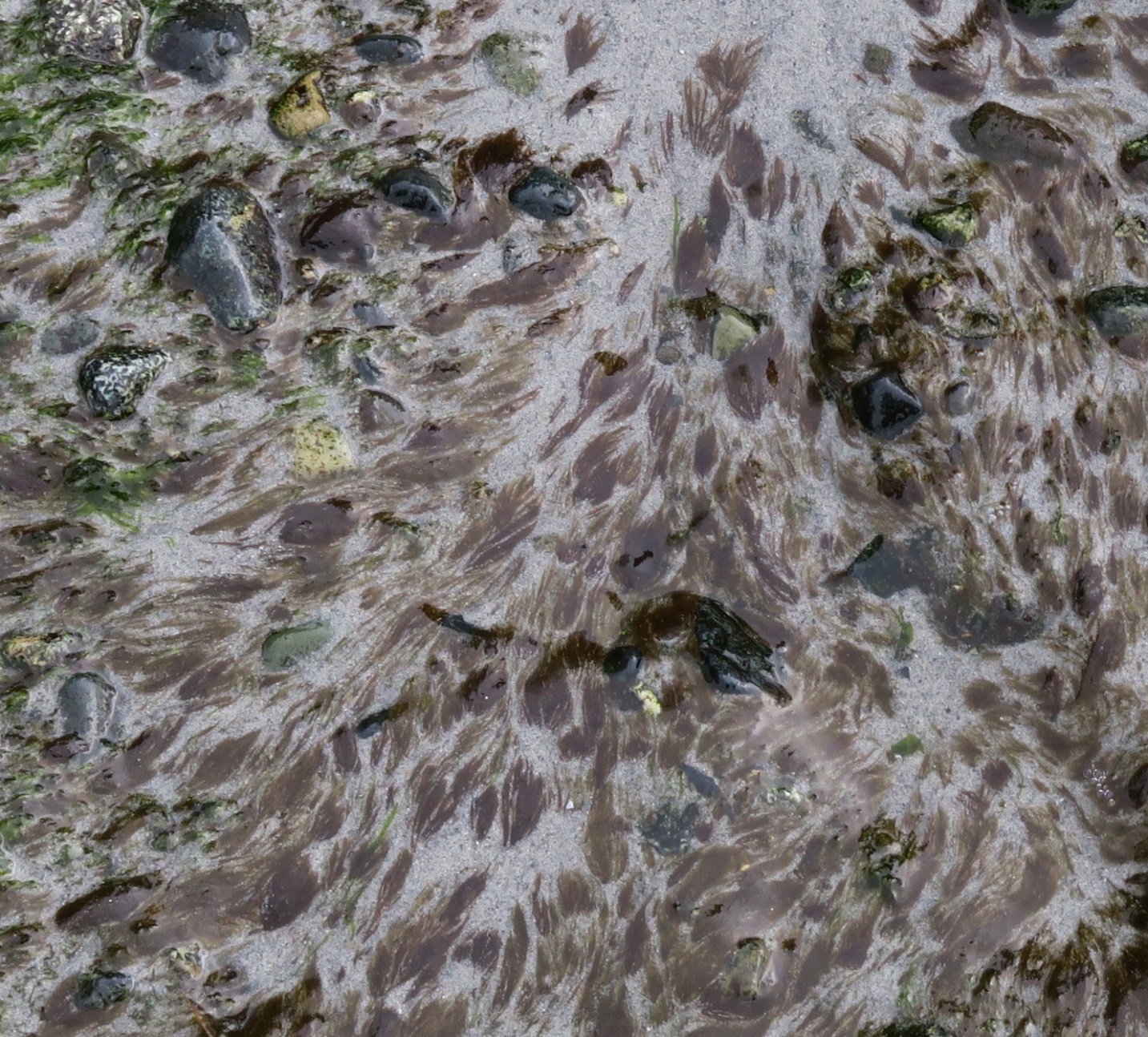
Brown Sea Tuft
Gonzales Bay, Juan de Fuca Strait, B.C., Canada
13 February 2023
Low tide 3.3 feet at 15:52pm PST (measured at Oak Bay Tidal Station)
Weather: Overcast, wind northeast 20 km/hour, no precipitation, light chop, low southerly swell, temperature 6 ˚C, relative humidity 82%.
Phase of Moon: Waning Crescent, 50.4%, or 23 days past the new moon; (Previous Phase, Third Quarter, 13 Feb 2023 at 08:00am PST; Next Phase, New Moon, 19 Feb 2023 at 11:05pm PST.)

Figure 1: A section of sand-covered concrete is adorned with numerous tufts of Battersia racemosa. These individuals are just covered in a thin bath of ocean water, and the points of the tufts reveal exactly what direction the water is flowing. Gonzales Bay, Juan de Fuca Strait, B.C., Canada. March 7, 2022. Photo ID 27552 ©Seaweedwhisperings.com
Person 1:
Wiggly.
Tadpole – energetic wiggles, then stops.
Hide & Seek. Now you see me, now you don’t.
Playful.
With wave action it seems to get into a rapid, energized motion, then spreads out relaxed-ly, then retreats to quietude.
The aggregation we interacted with today was associated with (and anchored to) the coarse pebbly concrete of an old storm sewer. Yesterday a thin layer of sand had washed over, obscuring most of the little seaweeds.
Playfulness – an expression of freedom from being covered with sand? Being playful might be a release from the reality of being smothered and an innate awareness that they only have a short life to explore possibilities.
Although tiny, by presenting itself in an attractive array, it invites interaction from others.
If it gets too much attention, however, does it long to hide in the sand?
Person 2 spent quite a bit of time playing with the wave action alongside Brown Sea Tuft; joining in with the play of water like the seaweed. In a way she was mimicking the seaweed in her actions, playing with the water; when later asked Person 2 said that this mimicry was unconscious – she just joined in.
Independent, but likes to have acquaintances; perhaps not forming deep relationships.

Figure 2: Battersia racemosa, a single ‘tuft’ is laid out on the sand beach; depending on the setting of your device this photo is likely to appear about eight times larger than life-sized. This filamentous brown alga was originally described in a book of Scottish Flora focusing primarily on the Fungi. It was found, also in February, at the estuary known as the Firth of Forth in Scotland and described in 1824 as a species of Sphacelaria. In 2010 new taxonomic work was done moving this seaweed to the genus, Battersia. February 11, 2023. Photo ID 27553 ©Seaweedwhisperings.com
Person 2:
At this time of year in our vicinity – February and March, if you head to the beach at the correct tide level you may be fortunate to find groupings of Brown Sea Tuft.
They grow attached to rock but adjacent to sandy beaches, so if the swell and currents have shifted the sand, these short filamentous brown algae can be easily hidden, buried under even a small layer of sand.
In the last few days we’ve been playing a bit of “hide & seek” with Battersia racemosa (which we’ve given the common name of Brown Sea Tuft). One day the small tufts of seaweed were making lovely patterns in the shallow water and also as they lay upon the sand. And then only one day later, most of these same tufts were all hidden from sight.
They seem to like this late winter season to grow here, and where they are located would be at the very high tide region of this intertidal zone in summertime. But at this time of year, the pull of the moon and the tilt of the planet combine to yield tide cycles that beautifully suit them. The groupings of Brown Sea Tufts look to be in prime condition.
They’re supple.
And grow in tuft-like arrangements in a larger collection of individuals.
They lay out of water exactly how the retreating currents leave them, and in this location that often means the total grouping of filaments belonging to one tuft takes on the graceful look of a tree leaf, one that is nicely rounded and then tapers to a point. You could also imagine them looking like a short and broad feather. Seen like this the pattern their shapes make is really very beautiful.
Next to the bright green colored Ulva intestinalis the Brown Sea Tufts might look rather drably colored in comparison. But if you look very closely, the brown is a warm light translucent caramel color and is really quite attractive.
The tiny filaments do seem to branch a bit, but not often and not in a clear pattern. I think the modest branching is what has the overall tuft broaden out in the middle portions and then also tapering in at its point.
Compliant, willing, moving with the water currents.
Seems to ENJOY such movements. Yes, I just smiled as I thought of this enjoy-ment; it is sensual, like a series of tickles delivered by choppy water. Or like a strong rush to move swiftly and ‘all-in’ with the force of a strong outflow.
Person 1 saw some movements that he likened to that of tadpoles, and as I recall that now I think, yes, that has the correct energy. Hide & seek, tickles, and tadpoles – young things that still find life to be full of games and rich with new experiences to try out.
Touching this seaweed is tricky to do if you’re a human; we’re so very large in comparison. My fingertips could just sense softness and possibly a slight fuzziness or even mushiness to the algae in the water.
Actually when immersed, the brown filaments look fuzzier and not nearly so delineated as when freshly exposed and out of water; if your vision is acute, you can make out the individual threads very well. Viewed when they are underwater these same filaments look larger, surely the water acts as a magnifier, and they also look a darker shade of brown.
Young / youthful energy and short-lived.
Your season is short, Battersia racemosa.
I think your attention span is short also. I found that unless I was fully in the “flow of ideas” that I was hearing from and about you in this Whispering, Brown Sea Tuft, I was apt to wander off topic. You may not have strong staying power, but you do have eager and keen interest when something is presently capturing your attention; and your attention can be ‘captured’ both physically with proprioception and intellectually via the imagination and drive to learn and try things out.
The grouping of you on this eroded chunk of concrete at the edge of the bay appears as if you’ve achieved a comfortable population size. You don’t crowd each other’s space and yet you do exist in close proximity one to another.
I think you all need enough room to “play” in the water as it moves you, and possibly also you don’t yet know how to settle “inter-algal” disputes. Best then to be sure to live in a manner that helps you to avoid such problems.
Crowding isn’t fun, nor is being alone.
Your “tufted” habit compares with what I’ve seen with wild grasses. When they are young and green and supple wild grasses move in the wind in a way that is reminiscent of how Brown Sea Tuft moves in the ocean currents. There is a rippling or waving of the numerous tufts that makes “visible the invisible” – the forces of wind and currents are given visible form.
Maybe with your exploratory play, Brown Sea Tuft, you innocently discover some realities of the world. But you have a short life and an obvious “young” energy. I think others might be suspect of the ‘realities’ you could describe. That could have the potential to dampen your spirits, Battersia racemosa, but mainly I think you can quite quickly renew your play and get immersed in the pleasure of trying out what next comes up – discovering how the next set of waves will move you and in that you so often find your personal delight.

Figure 3: This “habitat” shot shows the sand covered surface of an old cement storm sewer which abuts a natural rock outcrop (which extends to the right and mainly on and out of the picture). The scattering of ‘leaf-shaped’ Brown Sea Tufts are intermixed with the numerous green Ulva and red Pyropia species algae, a few clam shells, and the ever shifting sandy substrate. At this time of year, conditions seem to be ideal for Battersia racemosa. March 7, 2022. Photo ID 27554 ©Seaweedwhisperings.com
Discussion:
The original genus name for this species, Sphacelaria, is from the Greek meaning ‘gangrene’. Possibly some of these species impart this kind of look to host alga. If we consider that Greville first described the species we are interacting with now in a Flora focusing on the Fungi, then we could see that there is a natural association with decay, necrosis and mortification – as seen in the fungi group. It is interesting that one definition of “mortify” is “to subdue or deaden the body or bodily appetites”. This couldn’t be further from the experience of this Whispering in which we saw a keen appetite for life. Possibly there is a polarity, a side to this algae that does retreat into only memories of their playful and trying-it-out life energies? When smothered in sand, then this alga certainly is ‘deadened’ and cannot “play” and this may be only one circumstance in which another side to this simple filamentous alga is revealed.
When later researching the biology of this seaweed, we found that there is a notable distinction to this tiny brown alga; it employs asexual reproduction involving multicellular spores. The multicellular nature of the spores is apparently rare amongst seaweeds. It seems that Brown Sea Tuft has there again discovered something a bit different, and compared to other seaweeds tried something out that proved to be quite successful. It seems that there would be times that trying out and investigating new ways might not meet with success, and perhaps this links to the softness and suppleness of the algae. It is unlikely that Brown Sea Tuft would ever present with force or certainty, but more likely in a gentler fashion, as if they are aware that they may change their ideas as their experience grows, as a new ocean wave brings other results.
A physical symptom arose with this Whispering, that of bloodshot eyes or “red eye”. Person 2 noted this condition the day we did the Whispering and the day following. The look of the tiny blood vessels in the eye, reddened and therefore highly discernible, was reminiscent of the tiny little filaments of Brown Sea Tuft. One of the causes of red eye is what is called computer vision syndrome, which Person 2 could well have qualified for. Studies have shown that people tend to blink about half as much as normal when working on the computer creating this type of “digital eye strain”. Blinking increases tears and the moisture most suited to eye health. Possibly this symptom indicates a key vulnerability of Battersia racemosa; it would desiccate very quickly if left out of ocean water for very long, or in high winds, or at warmer air temperatures / seasons.
Their short attention span and the noted tendency to not form deep relationships combines to show the kind of character that is very friendly, and enjoys many acquaintances but that also likes to maintain its independence. We wondered if this is due to the noted difficulty in sorting out inter-personal issues; there is a preference to just move on or shift focus to another place rather than work it out.

Figure 4: The aggregation of Brown Sea Tuft shown here is ‘playing’ with the outflowing waters at Gonzales Bay. While not deep enough to allow the tufts to spread out fully, at this level the flow of water is giving the tiny brown filamentous algae plenty of force to move and interact with. February 13, 2023. Photo ID 27555 ©Seaweedwhisperings.com
Biology & Natural History Information:
Description:
From Greville’s original description in 1824, we know that Battersia racemosa is tufted, about one inch in height, olive green or olive brown in color. Fitting to its color, it is indeed a brown alga. The fronds are filiform, somewhat rigid, three to four times dichotomous and the dichotomies are acute. Racemes are sub-erect and arise from various parts along the frond.
Habitat:
Occurs as small tufts on rock, and other substrate. The type specimen, discovered by Dr. Richardson and described by Greville, was found in Scotland at the Firth of Forth, was growing of rocks near the high water mark; this is the same situation we found at Gonzales Bay. Other sources say that members of this genus and that of Sphacelaria are found in the lower and subtidal regions.
Range:
North American coastline from Alaska to California; Britain; Helgoland; White Sea, Russia.
Remarks:
This species, like others of the genus Battersia and Sphacelaria, are prime examples of algae ‘organization’ that arises from apical growth. The apical cells divide and produce and simple one-cell-wide filament. The cells of this filament continue such divisions, giving rise to a simple multicellular body. At maturity some of the branches modify their growth to produce multicellular reproductive spores which Greville described as “cluster-fruited”. This type of asexual reproduction involving multicellular spores is noted to be rare among seaweeds.
Classification:
Phylum: Ochrophyta
Class: Phaeophyceae
Order: Sphacelariales
Family: Sphacelariaceae
Genus: Battersia
Species: Battersia racemosa (Greville) Draisma, Prud’homme & H.Kawai 2010
Former name(s): Sphacelaria racemosa Greville 1824.

Figure 5: At the other end of the bay, more Brown Sea Tuft is growing; this time they are anchored to a large boulder which has a flat section that extends into the sand and water. There are a few small pieces of wood debris tangled up in the larges tuft shown here, yet the overall urge to flow and extend gracefully with the pull of the water is maintained. February 11, 2023. Photo ID 27556 ©Seaweedwhisperings.com
![]()